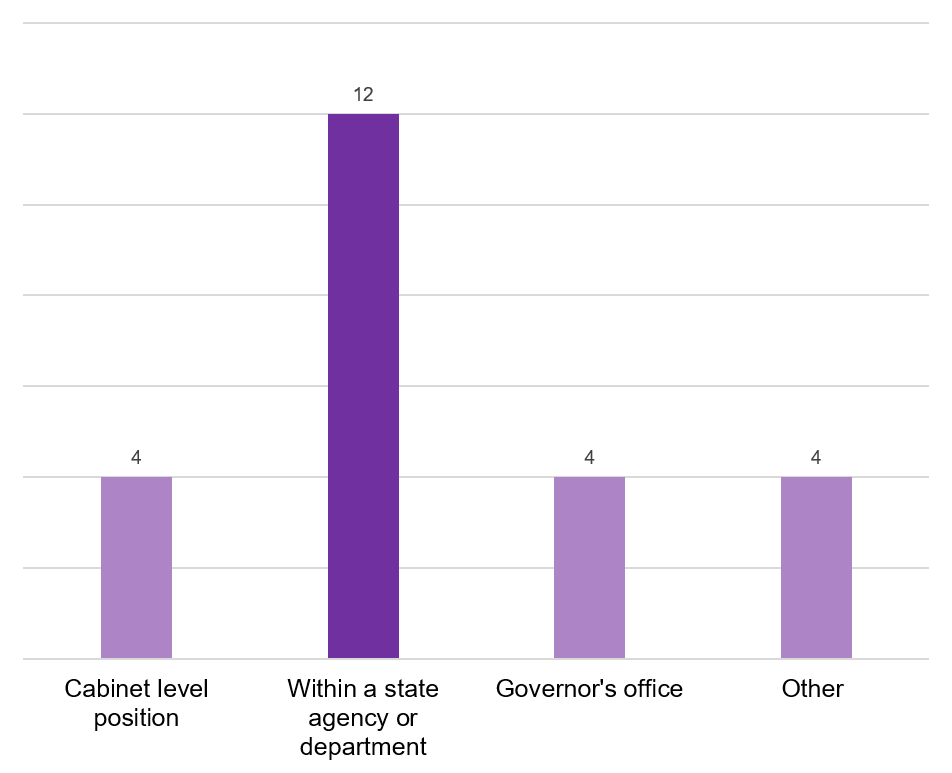To better understand the issues and needs of Governors, NGA conducted a survey in August 2020 on states’ and territories’ diversity, equity and inclusion activities, goals and challenges.
Summary
In the wake of tragedies including the killings of George Floyd and Ahmaud Arbery, the discourse around systemic racism has risen to the forefront of national consciousness. In addition, COVID-19 has further highlighted the many existing disparities in communities of color throughout the country. The discourse has prompted Governors to consider how state policies and programs can address bias and disparate impacts experienced by communities of color in the criminal justice system, health care and other policy areas.
To better understand the issues and needs of Governors, the National Governors Association (NGA) conducted a survey in August 2020 on states’ and territories’ diversity, equity and inclusion (DEI) activities, goals and challenges. A total of twenty-three states and territories responded, with a duplicate response from one state. [1] The responses illustrate the challenges Governors have faced, actions they have taken, and how they have organized their DEI efforts.
Key Takeaways
- The programmatic structure of DEI initiatives varies at the gubernatorial and the agency level.
- In response to the pandemic, states and territories have established COVID-19 health equity task forces.
- The biggest challenges for states and territories include budget and staffing levels and expertise.
Programmatic Structures
Governance structures vary across states where DEI is housed, led and supported.
- The DEI lead in two states holds a cabinet-level position that reports directly to the Governor, while the lead in two other states is not a cabinet-level officer but reports directly to the Governor on equity issues.
- Four DEI leads serve on the Governor’s staff or report to someone within the Governor’s office, and the remaining DEI leads who responded held “other” titles. [2]
- Four DEI leads are situated within their state’s Department of Health and Human Services (DHHS) and report to their DHHS commissioner.
States and territories reported the following breakdown of where their primary DEI initiative(s) are located with their respective governments:

Gubernatorial Actions
Governors have taken several actions to advance DEI within their state or territory. At least eleven states and territories said they had developed a DEI work plan or strategic plan, integrated DEI into their strategic plans, enacted legislation or issued an executive order that describes the state or territory’s DEI commitment, and/or established a COVID-19 health equity task force. States and territories with smaller populations tended to report more than their more populous counterparts that they have been integrating DEI into strategic plans. Two states created new departments to advance their DEI efforts— Governor’s Advisory Council on Diversity & Inclusion and an Office of Health Equity in the Department of Health, respectively. Other states and territories are incorporating DEI into their COVID-19 task forces as well.
States and territories reported having taken the following actions:

DEI Challenges
States and territories have expressed various challenges with initiating and sustaining their DEI efforts. A total of nineteen states and territories cited budget and eighteen cited staffing as primary challenges to their activities. Twelve respondents indicated the “lack of expertise and training” as challenges regarding their DEI initiatives. A total of eleven states and territories are concerned about program sustainability across gubernatorial administrations, while ten are concerned about obtaining buy-in from stakeholders for their DEI initiatives.
States and territories were provided a defined list of technical assistance options and asked them to select which is of the greatest interest (respondents could only choose one). A total of nine states and territories indicated that individualized technical assistance and tailored research is of the greatest interest; seven indicated that having regular peer-to-peer network calls to promote cross-state dialogue and featured expert speakers, as well as federal engagement (as desired); and three prioritized webinars as of the greatest interest. The balance of respondents indicated that they were equally interested in all three options or had a specific request (e.g., GIS and detailed data analysis).
Conclusion
In consideration of these survey results and continued coordination with NGA’s state and territorial partners, NGA is evaluating its next steps in how to best support Governors with achieving their DEI goals and objectives. While the survey has officially closed, states and territories are encouraged to share their DEI activities with NGA staff as they make changes and updates.
For questions or concerns related to the contents of this memo, please contact NGA staff:
- Maribel Ramos (mramos@nga.org; 202.624.5378)
- Carl Amritt (camritt@nga.org; 202.557.1593
[1] For the purposes of the following evaluation and analysis, both responses were counted
[2] “Other” titles varied widely among states and territories, including DEI as part of their job but DEI was not part of their title; some reported not having a specific DEI lead












